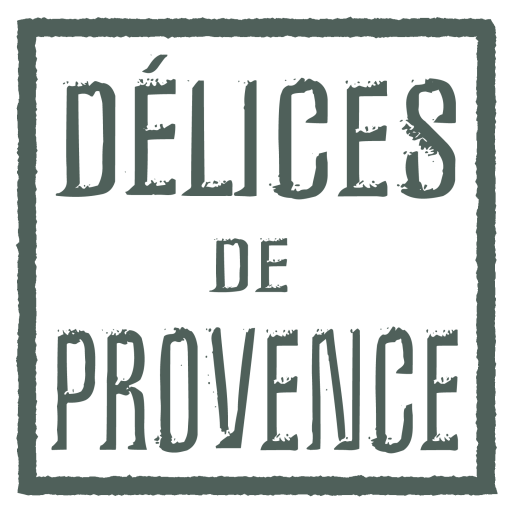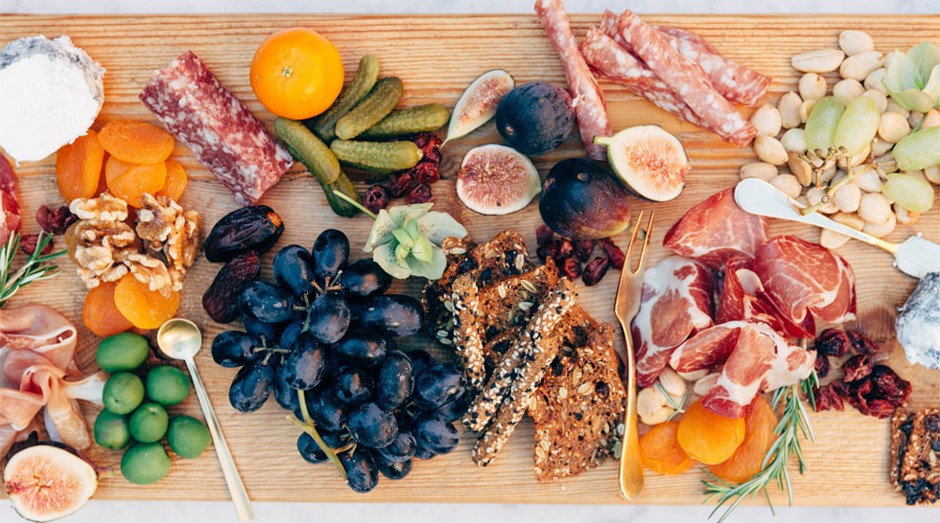With the weather warming up (and not before time, it’s nearly August – mon dieu!) it’s time to go all French and indulge in a time honoured tradition – Apéro. Leave the BBQ in the garage and dig out your wooden platters & small ceramic dishes, gather your emergency chairs and chill the Rosé. Follow our guide to host your own successful L’heure de l’Apéro – on the terrasse if the sun’s still out!?

“What the hell is Apéro!?” I hear you cry. Apéro is a shortened version of Apéritif, a drink taken before dinner. Apéro however is a little more than a drink and always involves something to eat. It is one of France’s best loved traditions and almost a daily ritual, keenly observed and anticipated. It can be as simple as meeting a friend or colleague for a drink after work with a couple of olives or elevated to a special social occasion lasting several hours. One thing it isn’t though, it is not a dinner party. Apéro in Provence combines the holy trinity – food, drink & conversation.
Although it is a time to relax amongst friends or family, if you are the host of a ‘special occasion’, planning, preparing and delivery is a very serious affair. You will be judged on your Apéro! This isn’t just chip & dip you know (unless you have made them yourself). Having said this, if you are having a small informal gathering chez-nous then a bowl of olives and a few pistachios will be gratefully received without your soiree being the topic of discussion at the boulangerie the following morning!
What would you like to drink?
In Provence, there are two traditional paths to follow when it comes to an apéritif, wines (including bubbles and wine based drinks) or herb/spiced based drinks inluding pastis & Campari. In the summer months, rosé is more than likely the wine of choice on offer and by god can they make a good rosé in Provence! Unlike the sickly sweet, neon pink cough syrup so readily available in the UK, Provence rosé is pale, extremely fresh and crisp, almost certainly very young and usually packs a punch alcohol wise! It is the perfect glass before dinner which makes it an ideal choice for Apéro. The best examples we have found readily available in the UK are from Mirabeau. You can learn more about Provence Rosé here.
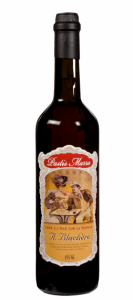 On special occasions it is usual to enjoy a Kir, white wine with a splash of crème de cassis (a rather syrupy liqueur made from blackcurrants), or a step up, Kir Royale, made with champagne rather than still wine. However, ordering a Kir has become a little passé, why not try something you wouldn’t usually ask for? Order pastis and the waiter will bring a glass filled with a little of the drink with a carafe of ice water so that you can add the amount of water you prefer, generally with a proportion not exceeding 1 part liquor to 5 parts water. As the water is added, the mixture changes to a milky, off-white concoction with a strong aroma of aniseed. It is perfect enjoyed before a meal on a hot summers day and will, according to Provence locals, aid digestion – win, win! Delicious, alcoholic and medicinal! Our favourite in Provence is Marra, the local speciality of L’isle sur la Sorgue. Each region has a locally produced pastis, each with it’s own secret recipe, and everyone will tell you of their favourite and extol it’s unique virtues as to why it is the best. When buying in the UK, unless you find a merchant who specialises in pastis, we tend to opt for Ricard.
On special occasions it is usual to enjoy a Kir, white wine with a splash of crème de cassis (a rather syrupy liqueur made from blackcurrants), or a step up, Kir Royale, made with champagne rather than still wine. However, ordering a Kir has become a little passé, why not try something you wouldn’t usually ask for? Order pastis and the waiter will bring a glass filled with a little of the drink with a carafe of ice water so that you can add the amount of water you prefer, generally with a proportion not exceeding 1 part liquor to 5 parts water. As the water is added, the mixture changes to a milky, off-white concoction with a strong aroma of aniseed. It is perfect enjoyed before a meal on a hot summers day and will, according to Provence locals, aid digestion – win, win! Delicious, alcoholic and medicinal! Our favourite in Provence is Marra, the local speciality of L’isle sur la Sorgue. Each region has a locally produced pastis, each with it’s own secret recipe, and everyone will tell you of their favourite and extol it’s unique virtues as to why it is the best. When buying in the UK, unless you find a merchant who specialises in pastis, we tend to opt for Ricard.
What would you like to nibble? (Oh, behave!)
So with the wine chilling, the pastis on the drinks tray and the ice in the freezer, we move on to what to serve your guests to line their stomachs. As we said earlier, apéro is not a dinner party. Sometimes it will be a short affair, lasting only 30 minutes to an hour, but more often than not your guests will enter into the full spirit of l’heure de l’apéro and sit chatting and imbibing for 2 or 3 hours. Finger food is the order of the day, if your evening is to be a long leisurely one bring your treats out at intervals leaving enough space in between each offering to allow their hunger to increase with another top-up (but don’t leave them starving!)
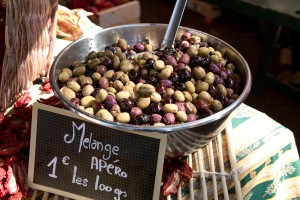
Olives are an ever present guest at any Provencal gathering. Every market will have at least one olive stall bulging with huge bowls of plump fruits offering a vast array of different varieties and flavour combinations. Olives with chilli, herbs de Provence, whole raw garlic cloves, sweet peppers etc. It’s nearly impossible to wind your way through a market in France without a morsel of cheese, a slice of baguette smothered in tapenade or an olive being thrust into your hand for you to sample. Visit your local deli to find something a little different and don’t be afraid to ask to try before you buy!
Aïoli is a pungent garlic flavoured ‘dip’ which is very similar to mayonnaise. The name means “oil and garlic” in Catalan and Provençal. It is often served with crudités, boiled eggs and slices of baguette. It is well worth the effort to make yourself but be sure to only invite garlic lovers to indulge as some may find it quite overpowering.
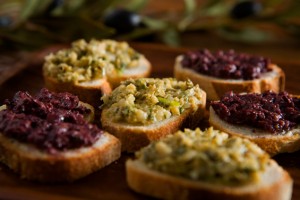 Tapenade, anchoïade and other savoury ‘spreads’ or tartinades are also a popular choice for apéro and in most peoples homes they are essential. They can be enjoyed as dips but are more commonly spread on thin slices of fresh or toasted baguette. Tapenade is a speciality of Provence which, in it’s most basic form, consists of very finely minced or puréed black or green olives. Other flavourings are often added including capers, herbs or anchovies. If you are an anchovy fan then you must try anchoïade, a gutsy, salty spread also of Provençal origin. Other tartinades include pistou (Provençal pesto), aubergine or tomato caviar and sardinade. There are many varieties available so why not try them all and discover your new favourite!?
Tapenade, anchoïade and other savoury ‘spreads’ or tartinades are also a popular choice for apéro and in most peoples homes they are essential. They can be enjoyed as dips but are more commonly spread on thin slices of fresh or toasted baguette. Tapenade is a speciality of Provence which, in it’s most basic form, consists of very finely minced or puréed black or green olives. Other flavourings are often added including capers, herbs or anchovies. If you are an anchovy fan then you must try anchoïade, a gutsy, salty spread also of Provençal origin. Other tartinades include pistou (Provençal pesto), aubergine or tomato caviar and sardinade. There are many varieties available so why not try them all and discover your new favourite!?
Fruit & nuts are also served in pretty little ceramic dishes, often made at a local pottery. The choice here is entirely up to your own personal taste. We like to serve seasonal fresh fruits and some good quality dried fruits that are out of season. Peaches are perfect at this time of year – late July – but imported peaches can never quite compare with those picked whilst at their peak and eaten at a market in France, but they still make a fantastic summer treat. Figs are a must if you’re hosting an Autumn apéro. Try lightly toasting some unsalted nuts in a dry frying pan or under the grill, you will be amazed at the difference it makes to the flavour. Keep an eye on them though as it only takes a split second for them to catch and you will have resign them to the bin and start again.
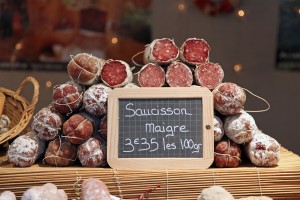
Saucisson (salami) are delicious to nibble with a drink and, again, the options seem almost endless. Flavoured with garlic, herbs de Provence, hazelnuts, olives etc. There are regional specialities such as wild boar (sanglier) in Provence and a whole range of shapes and sizes – look out for the tiny balls of saucisson on a string that resemble Christmas tree decorations and the petite, thin ‘cocktail’ saucisson which can be cut into thin discs measuring barely a centimetre across. Served with a bowl of good quality cornichons they are sure to be a crowd pleaser! Spending the time and effort to find a local deli which specialises in charcuterie will be well rewarded, you’ll never open a supermarket vacuum packed, pre-sliced sausage again!
Has this whet your appetite and given you a few ideas? We hope that you will adopt the idea of l’heure de l’apéro and build into into your daily routine. It offers the perfect chance to spend a little time with those close to you and unwind from your busy life. Just remember, it only takes a couple of drinks and a bowl of olives but the reward is far greater!
Why not host your own L’heure de l’Apéro and tell us how it went?

